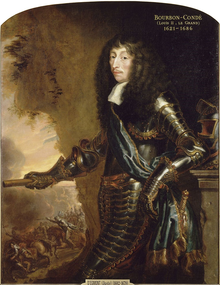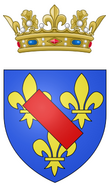Louis II de Bourbon, prince de Condé
Louis II. De Bourbon, prince de Condé (born September 8, 1621 in Paris , † December 11, 1686 in Fontainebleau ), also known as "Le Grand Condé" , was the first prince of the blood of the French royal house of Bourbon . He is considered one of the most important generals of the 17th century and, as the leader of the aristocratic opposition to Cardinal Mazarin, played an important role during the Fronde civil war , as a result of which Condé was forced to flee to Spain. After his pardon from Louis XIV , he became the king's most important commander in the war of devolution and the Dutch war alongside Turenne .
biography
Origin and years of youth
Louis was born as the eldest son of Henri II de Bourbon (1588-1646), the third Prince de Condé , and his wife Charlotte-Marguerite de Montmorency . Thanks to his quality as a potential heir to the throne and the wealth of his family, the Duc d'Enghien , as he was called when he was young, was one of the highest-ranking people in the country. For a time when a humanistic education in the high nobility was not necessarily an ideal, he received an exceptionally good education, from 1629 at the Jesuit college of Sainte-Marie in Bourges . He reported on his progress in Latin letters to his father. After six years, at 14, he left the college and turned to studying military science .
In 1638 he took on responsibility for the first time: during an absence of his father, he served as governor of the Duchy of Burgundy (Bourgogne). At this point, however, he was still subject to the authority of his father, who was even represented by a tutor. Although the prince was over 18 years old, the father managed his life down to the smallest detail, such as the daily wardrobe. Louis' service in the French army, in which he volunteered in 1640, brought some relief. In the same year he gained his first war experience during the siege of Arras , but without particularly distinguishing himself.
In the meantime, his father Henri II set about arranging an advantageous marriage for his son. His choice fell on the just twelve-year-old Claire-Clémence de Maillé-Brézé (1628–1694), a daughter of the Maréchal Urbain de Maillé, marquis de Brézé (1597–1650). The Maréchal himself had married a sister of Cardinal Richelieu , who at the time largely controlled the political leadership of France. Thus Claire Cleménce was the cardinal's niece. Henri II hoped to gain further advantages and influence at court through an association with the cardinal's family. Louis thought similarly, because although he was rather negative towards his wife, he was aware that Richelieu could promote his political ambitions and help him to a field command in the army. The marriage was concluded on February 11, 1641 in the Palais Cardinal in Paris. From her four children were born, of which only one son, Henri III. Jules (1643–1709), should survive.
Career in the Thirty Years War
The association with the cardinal's family paid off. After a few minor military commands, Louis d'Enghien was given command of the French army on the border with the Spanish Netherlands in the spring of 1643 . At this time France was at war with Spain (→ Franco-Spanish War (1635–1659) ) and against the Habsburg Emperor of the Holy Roman Empire (→ Thirty Years War ). The numerically superior Spanish army opened the campaign with the siege of the border fortress Rocroi . To frighten them, Enghien went with the French army and attacked the Spaniards, contrary to the advice of older officers, on May 19, 1643, despite his inferiority. It caused a crushing defeat for the Spanish troops, which then had to withdraw from France. The Battle of Rocroi made Enghien famous in one fell swoop. It is still considered to be a turning point from which France rose to become a European hegemonic power. Enghien himself insisted on a few days' leave after the fight in order to be celebrated in Paris as a glorious hero. Here the great vanity that characterizes him was already evident, which would later turn into arrogance.

In the following year 1644, Enghien commanded the French armies in Germany. Together with Maréchal de Turenne (1611–1675) he led the bloody battle near Freiburg (3rd to 9th August 1644) and pushed the Bavarian army away from the Rhine. As a result of this success, important fortresses fell to France. In the following year, Turenne and Enghien operated together and again defeated the imperial and Bavarian troops in the battle of Alerheim (August 3, 1645). However, these two victories cost the French armed forces great losses and were therefore received with little enthusiasm in Paris. At court criticism of Louis d'Enghien came up.
In 1646 Henri II died and his son Louis bequeathed the title of Prince de Condé as well as all of his property and possessions. Enghien thus became the most powerful aristocrat in France. He now possessed great wealth, vast estates, royal blood, a large following and, after the capture of Dunkirk in the same year, a brilliant military reputation. All of this made him suspicious in the eyes of Cardinal Mazarin (1602–1661). Richelieu died in 1642 and King Louis XIII in 1643 . At this time, the heir to the throne, Louis XIV, was only five years old. His mother Anna of Austria (1601–1666) therefore exercised the reign with the help of the cardinal. Due to his high birth and social position, Condé had a great influence on government affairs, especially since he had inherited his place in the Conseil d'État (Royal Council / Council of State) from his father .
Mazarin therefore tried to keep the prince away from court. First he entrusted him with command of the French troops in Catalonia . Here Condé failed for the first time; he did not succeed in 1647 to take the city of Lerida . He therefore refused to command again in this theater of war. Mazarin also offered to lead an expedition to Naples , which at the time was in revolt against Spain. There he could have won a royal throne, which too would have permanently removed the prince from the French court. But Condé refused the unsafe enterprise and instead took command of the French troops in the Spanish Netherlands again in 1648. There he won another victory over the Spanish troops on August 20, 1648 in the Battle of Lens . The outcome was more striking than almost any other at that time, because the Spanish army was almost completely wiped out. The win at Lens was in no way inferior to Rocroi's success five years earlier. He strengthened France's negotiating position at the Peace Congress in Munster, which was concluded two months later with the Peace of Westphalia .
Opposition during the Fronde

During the Fronde uprising that began in 1648 , Condé first supported Cardinal Mazarin and the regent Anna of Austria . In the following years he de facto became the most influential man in France, but behaved haughty and presumptuous in the eyes of those around him. He repeatedly insulted Cardinal Mazarin and did not shy away from physical violence. Because of these facts, he was imprisoned in the fortress of Vincennes from January 1650 to February 1651 , which broke out the second part of the uprising, that of the "princes". The fact that he and his brother Conti fell out didn't prevent them. After his release in 1651, he headed the troops of the Fronde, but was defeated on July 2, 1652 by Turenne and his troops loyal to the king outside Paris.
On March 27, 1653 he was sentenced to death by beheading in absentia. His possessions were confiscated.
He fled to Spain and served the Spanish King Philip IV as a general. After the Peace of the Pyrenees , which was favorable for France in 1659, Condé was amnestied and returned to France.
Return and life under Louis XIV.
In the brief period of peace that followed, Condé a. a. as a patron and sponsored Molière , for example , by allowing him private performances of the forbidden play Le Tartuffe .
In 1668 he commanded the troops that, on the orders of King Louis XIV, took over the then Spanish Franche-Comté .
1672–1674 he was general of the French troops in the Dutch War , through which Ludwig appropriated parts of the Spanish Netherlands. In 1675 he was briefly commander in chief of the French troops in Alsace .
In 1675 Condé retired to his Chantilly Castle , where he was again active as a collector and patron. He died on December 11, 1686 in Fontainebleau .
Trivia
In memory of the "Great Condé", King Frederick the Great of Prussia named his favorite horse, a Trakehner gray horse, Condé .
Individual evidence
- ↑ Additional titles: Duke of Enghien, Albret, Bourbon, Montmorency, Châteauroux, Bellegarde, Damville, Beaupréau and Fronsac, Count of Charolais and Chemillé, Peer of France, First Prince of the Blood , Governor of Burgundy, Grand Master of France and Knight of the Order of the Holy Spirit
- ↑ James Breck Perkins: The Great Condé , in: The English Historical Review 3 (1888), No. 11, p. 481
- ↑ James Breck Perkins: The Great Condé , in: The English Historical Review 3 (1888), No. 11, pp. 482f
- ↑ A clear representation of the battle is offered by: Geoffrey Regan: Battles that changed History , London 2002, pp. 109–112
- ↑ James Breck Perkins: The Great Condé , in: The English Historical Review 3 (1888), No. 11, p. 485
- ↑ cf. Franz Kugler , History of Frederick the Great , Leipzig: Reprint-Verlag o. J., p. 600 f.
literature
- Jean de La Brune: Memoires Pour Servir À L'Histoire De Louis De Bourbon, Prince De Condé , Marteau, Cologne 1693.
- Henri Chérot: Le grand Condé, son fils, le duc d'Enghien, son petit-fils, le duc de Bourbon; Trois éducations princières au dix-septieme siècle 1630-1684 , Descle de Brouwer & Company, Lille 1896.
- Pierre Coste: Histoire de Louis de Bourbon II du nom, prince de Condé, premier prince du sang , Cologne 1693.
- Joseph Louis Ripault Desormeaux: Histoire De Louis De Bourbon, Second Du Nom, Prince De Condé, Premier Prince Du Sang, Umgebung Le Grand - Ornée de Plans de Sièges et de Batailles , Saillant, Paris 1766. (4 vol.)
- Eveline Godley: The great Condé - A life of Louis II. De Bourbon, Prince of Condé , Murray, London 1915.
- Henri Malo: Le grand Condé , Michel, Paris 1937.
- Georges Mongrédien: Le Grand Condé , Hachette, Paris 1959.
- James Breck Perkins: The Great Condé , in: The English Historical Review 3 (1888), No. 11, pp. 478-497.
- Philip Henry Stanhope: The life of Louis, prince of Condé, surnamed the Great , London 1845.
- François H. Turpin: La vie de Louis de Bourbon, II. Du nom, prince de Condé, faisant la suite des hommes illustres de la France , Amsterdam / Paris 1767. (2 vol.)
- Simone Bertière: Condé: le héros fourvoyé , Paris: Éd. de Fallois, 2011, ISBN 978-2-87706-777-5
Web links
- Publications by and about Louis II. De Bourbon, prince de Condé in VD 17 .
- Tripota - Trier portrait database
| personal data | |
|---|---|
| SURNAME | Bourbon, Louis II. De, prince de Condé |
| ALTERNATIVE NAMES | Bourbon, Ludwig II of; Prince of Condé |
| BRIEF DESCRIPTION | French general |
| DATE OF BIRTH | September 8, 1621 |
| PLACE OF BIRTH | Paris |
| DATE OF DEATH | December 11, 1686 |
| Place of death | Fontainebleau |

